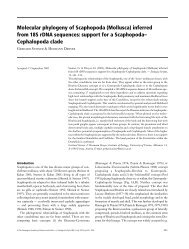Optimum Sample Size to Detect Perturbation Effects: The ...
Optimum Sample Size to Detect Perturbation Effects: The ...
Optimum Sample Size to Detect Perturbation Effects: The ...
Create successful ePaper yourself
Turn your PDF publications into a flip-book with our unique Google optimized e-Paper software.
Power analysis for sample size estimations 3<br />
size (n), sampling design, variability of sampling and effect size. Effect size is the magnitude<br />
of the true effect. <strong>The</strong> larger it is, the more likely a given design with a given<br />
sample size will correctly reject H 0 at a stated a level. Additionally, it is possible <strong>to</strong><br />
evaluate the quality of sampling design and the size of sampling units, especially when<br />
it is necessary <strong>to</strong> satisfy the assumptions of normality of a data set for parametric tests<br />
and the homogeneity of variances for parametric and non-parametric tests (Underwood,<br />
1981, 1997).<br />
<strong>The</strong>re are two types of statistical power analysis: the first is before the start of data<br />
collection programs, experiments or management manipulations (a priori power analysis),<br />
the second afterwards when the work has been done (a posteriori power analysis).<br />
A priori analysis is commonly used in fisheries sciences before starting an experiment<br />
or management program in order <strong>to</strong> estimate the sample size necessary <strong>to</strong> generate acceptably<br />
high power. Another application is <strong>to</strong> plan the magnitude of treatment perturbations<br />
(effect sizes) necessary <strong>to</strong> produce high power. It is also used <strong>to</strong> determine<br />
beforehand how large an effect size would need <strong>to</strong> be in order <strong>to</strong> give an acceptable<br />
power, given a planned sample size. On the other hand, a posteriori analysis is relevant<br />
only when interpreting the results of a statistical test that has already failed <strong>to</strong> reject the<br />
null hypothesis (for more details see the excellent work of Peterman, 1990a).<br />
2. Data analysis<br />
Based on the results obtained by Mouillot et al. (1999) (from their Tables 5 and 6), estimations<br />
of power curves were calculated for N° of samples having variability coefficients<br />
of 10 and 25 %. This procedure was carried out utilising the power tables for<br />
ANOVA design (from 2 <strong>to</strong> 25 N° of treatments) described by Cohen (1988) at three<br />
different levels of effect size: small, medium and large (0.1, 0.25 and 0.4, respectively).<br />
Note that these levels of effect size were taken from the social sciences context and<br />
`small', `medium' and `large' may not be suitable for biological and ecological studies.<br />
In the present analysis, these are only used as extreme possible situations. <strong>The</strong> a rate<br />
was fixed at 0.05 and the acceptable power at 0.80 (b = 0.20). <strong>The</strong>se levels of a and b<br />
are usually defined as the minimum acceptable (Peterman, 1990a; Peterman & M'Gonigle,<br />
1992; Schlese & Nelson, 1996; Ribic & Ganio, 1996; Underwood, 1981, 1997),<br />
although, under a conservative test hypothesis, they must be set a = b, or at a desired<br />
power = 0.95 for a = 0.05 (Peterman, 1990a). Additionally, Maps<strong>to</strong>ne (1995) proposed<br />
a procedure for determining the a and b rate that is based on the magnitude of impacts<br />
(effect sizes). Using power analysis it is possible <strong>to</strong> increase the robustness of any statistical<br />
test, which means that in testing a working hypothesis (e.g., perturbation) the<br />
probability of Type I and Type II statistical errors is simultaneously decreased (Tiku et<br />
al., 1986).<br />
Finally, the results of Mouillot et al.'s (1999) work (see their Tables 5 and 6) were<br />
separated by habitat and time: (1) Seagrass habitat west for June, July and August, (2)<br />
Rocky bot<strong>to</strong>ms south for Oc<strong>to</strong>ber, November and December and (3) Rocky bot<strong>to</strong>ms<br />
east for November and December (Table 1). <strong>The</strong> sample size (n) used <strong>to</strong> calculate the<br />
power curves was the average of those obtained by Mouillot et al. (1999) per habitat for<br />
the two coefficients of variation (10 % and 25 %).








